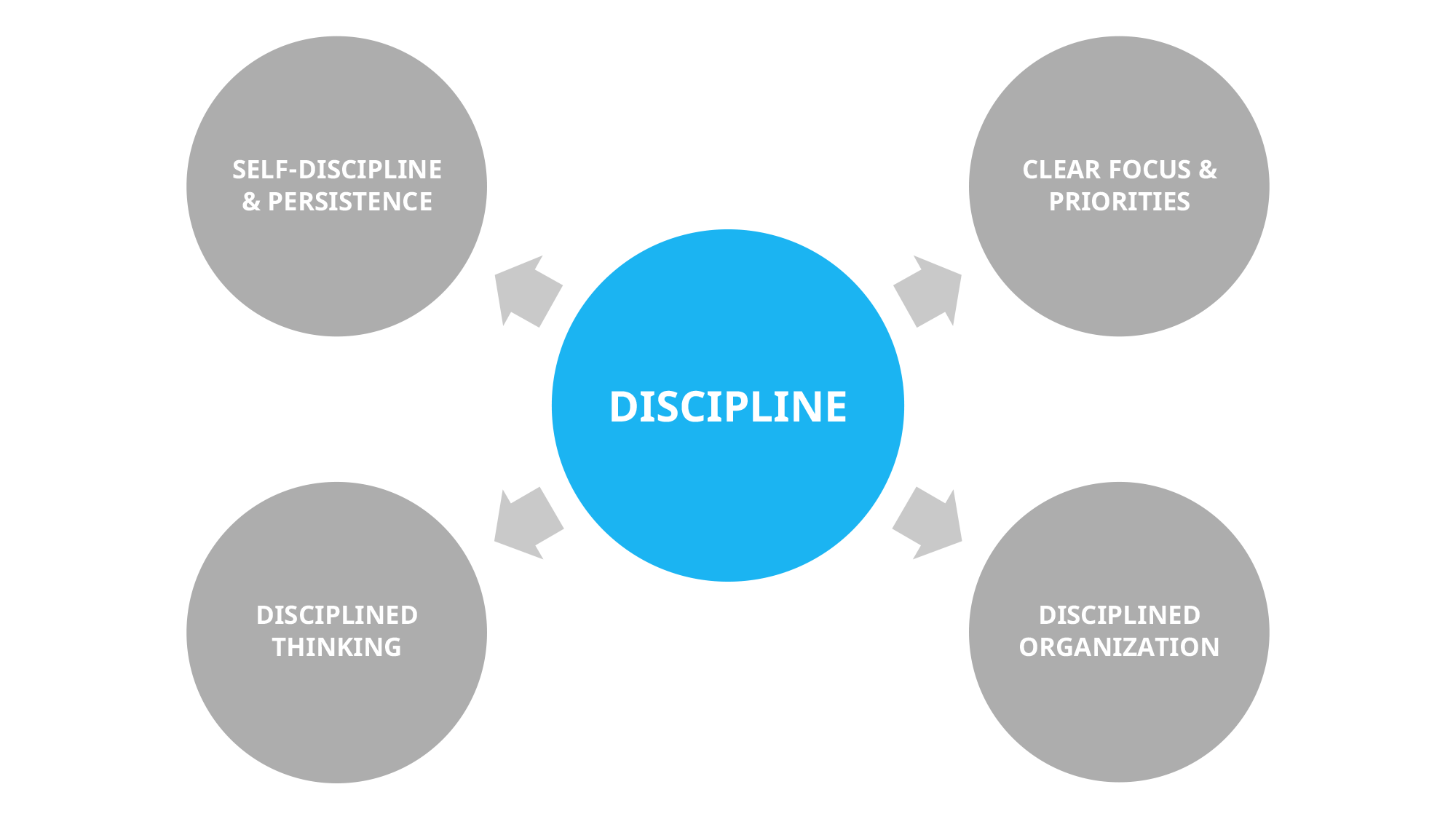The Role of Discipline in Innovation
Innovation is, without a doubt, a creative endeavor. However, many people still think it’s all about creativity. There’s a magical a-ha moment, and the rest is history.
Well, as we’ve explained before, that’s just not true. Those who have really been trying to innovate know that there is much more hard work than there is fun and games in the process of creating and scaling an innovation.
Thus, discipline plays a huge role in innovation. In fact, I’d argue that discipline is one of the least spoken about, yet most important factors determining whether individuals and organizations succeed at creating innovations.
So, in this article, we’ll dive deeper into the topic and discuss the role discipline plays in innovation to hopefully help you and your organization do a better job at it.
Table of contents

What is discipline?
As a term, discipline is commonly used to just refer to being strong-willed enough to put in a lot of hard work. In other words, self-discipline.
However, if we look at a dictionary, there are a few distinct but connected uses for the word. One refers to it as a branch of science, skill or type of work, another as the practice of regulating the behavior of people in a system, and the third as a synonym for punishing people for undesirable behavior in that system.
Well, innovation is certainly a discipline in the first meaning of the word, but it’s also one that takes a lot of discipline to succeed at, in the second meaning of the word.
Innovation is a discipline that takes a lot of discipline to succeed at.
Let’s dive a bit deeper on that second meaning for the word. For our purposes, we can further divide that it into two categories:
- Self-discipline
- Organizational discipline
There’s obviously a lot these two words have in common, but for an organization to succeed at innovation, you need both.
In a nutshell, you need self-disciplined individuals willing to put their head down and persist. But you also need organizational discipline to focus on what matters, and to create the incentive structures needed to reinforce all of that.
Why is discipline so important for innovation?
So, with that covered, we can dive deeper into why discipline is so important for innovation and how that happens in practice.
We’ll next cover each of the main points briefly.

It takes hard work, persistence, and focus to create an innovation
Because our software is centered around ideas, we often have to explain that while every innovation starts from an idea, an idea is maybe 1% of the way there towards a real innovation. It still needs development, refinement, implementation, scaling, and so on.
Going through that whole process takes a lot of hard work for pretty much every idea, even if the idea might seem trivial at first. The fact is that by the time you get an idea, hundreds, thousands or maybe even millions of people have probably had the same idea before. Most have just never bothered to implement it, or at least haven’t succeeded at it.
Every innovator will face plenty of challenges on the way, and there will be plenty of times when things look dire, and you could give up.
Every innovator will face plenty of challenges on the way, and there will be plenty of times when things look dire, and you could give up. Most do. But to succeed, you need to persevere and persist through these hardships.
To do that, you’re going to need a lot of discipline to avoid potential distractions, keep your head down and focus on what matters.
Trust the process and keep going
If you’ve ever been following a challenging fitness program, you know the feeling when it looks like you’re working your butt off and not making any progress.
The weights feel even heavier than they did the last time. That’s because you’ve been accumulating stress on your body, and it hasn’t yet had the opportunity to respond. Once you get some rest and recover from that stress caused by the exercise, the body will react to the stress and make you stronger. Well, the journey is the same with innovation: facing those stressors will feel challenging, but if you don’t give up, that’s what will make both you and the innovation better.
Well, the journey is the same with innovation: facing those stressors will feel challenging, but if you don’t give up, that’s what will make both you and the innovation better.
To keep using the same metaphor, if you’d like to run a 3-hour marathon, your fitness program will obviously look very different from if you instead wanted to squat 500 pounds. Similarly, if your strategy calls for incremental innovation, your innovation processes will look very different from those aiming for disruptive innovation, but more on that here.
Regardless, the key in each of these situations is to just trust the process and keep going. Even when things don’t look great. The challenges you face will shape your innovation for the better, and the results will follow – or you’ll run out of money. Regardless, you just need the discipline to persist and stay on track.
While following the process is what will eventually get you there, you of course need to make sure you're on the right path in the first place, and that is where disciplined thinking comes into play.
It’s easy to fool yourself without disciplined thinking
Our brain has a natural tendency to take mental shortcuts. We have an ability to recognize patterns and use those to make quick decisions efficiently and thus save energy. In most everyday situations, that ability is obviously very beneficial.
However, with innovation, this is often problematic. It’s these mental shortcuts that lead to many of the root causes behind issues that prevent organizations from innovating. This is perhaps easiest captured in common sayings like “This is how we’ve always done it” and “There’s no way that could work”.
Our brain has a natural tendency to take mental shortcuts, which is the root cause behind many obstacles for innovation. Disciplined thinking is how you combat that.
What’s more, if you’re an optimistic person, as most people working on innovation usually are, it’s easy to fool yourself to think that you have created something valuable even when you really haven’t. We often prematurely fall in love with that solution, instead of the problem.
Remaining highly analytical and rational in your decision-making while still being creative and aspirational is a tough combination for any person, or even for a team, to have.
Achieving that balance takes a lot of disciplined thinking. You need to stay grounded in reality, be willing to question yourself, and go back to first principles while still relentlessly moving forward. It’s a mindset anyone can learn, but that requires constant discipline to maintain.
Most organizations lack discipline
However, even if you are a good innovator, and have a great team that ticks all the boxes we’ve talked about above, it doesn’t mean that you’re automatically going to succeed.
One of the big barriers for that is the lack of organizational discipline. This is common for both startups and large organizations alike.
The idea is simple to understand. Just like an individual must remain focused to become great at something, so does an organization.
You need to make tough choices to have a clear strategy. That means saying no to a lot of things, so that you can focus on the things that will truly make a difference. Sometimes you might have to keep investing in these truly strategically important areas, even if there’s no quantifiable ROI in the near term. Again, at the same time, the organization needs the discipline to not think about sunk costs and ruthlessly kill innovation projects that have proven to not be able to live up to their potential to free up resources for the ones that have the best odds of success.
Sometimes you might have to keep investing in these truly strategically important areas, even if there’s no quantifiable ROI in the near term. Again, at the same time, the organization needs the discipline to not think about sunk costs and ruthlessly kill innovation projects that have proven to not be able to live up to their potential to free up resources for the ones that have the best odds of success.
That might sound like a paradoxical combination, and to a certain extent, it is. But that’s what makes it interesting.
On the execution side, you need a lot of discipline to have clear roles and set clear goals so that people have the prerequisites for succeeding, but also leave innovators with enough freedom to explore the best way to reach those goals. Again, that is a difficult combination to achieve. It requires a lot of discipline at all levels of the organization.
In our experience, most organizations just aren’t there yet, even if many individuals within the organization would be, and that is a big barrier for innovation.
As a result, corporate innovators often end up burning out or losing their motivation just trying to navigate the maze of organizational hierarchy for one permission and approval after another before they even get to start working on an innovation. That is a clear sign of an organization that isn’t disciplined – or alternatively has chosen to not innovate.
Discipline in practice
We’ve covered a lot of ground, and most of that has been pretty abstract, so before we wrap up, I’ll share a more practical example with you.
It’s a cliché to use Steve Jobs and Apple as an example for innovation, so I don’t usually like to do that. However, for this specific topic, I think it’s the perfect illustration because people usually see Jobs as this creative visionary and the ultimate ideas guy who couldn’t care less about processes or discipline.
But in fact, the first thing he did when coming back to Apple in 1997 wasn’t to come up with cool new products. It was to introduce a ton of discipline in everything they did and ruthlessly cut back on anything that didn’t truly help them innovate and create better products going forward.
First, he cut 70% of the products the company offered, and as a result, had to lay off 3,000 employees. Jim Collins does a great job summarizing some of the other actions in his book Great by Choice: ”They cut perks, stopped funding the corporate sabbatical program, improved operating efficiency, lowered overall cost structure, and got people focused on the intense ‘work all day and all of the night’ ethos that’d characterized Apple in its early years. Overhead costs fell. The cash-to-current-liabilities doubled, and then tripled.”
Jim Collins does a great job summarizing some of the other actions in his book Great by Choice: ”They cut perks, stopped funding the corporate sabbatical program, improved operating efficiency, lowered overall cost structure, and got people focused on the intense ‘work all day and all of the night’ ethos that’d characterized Apple in its early years. Overhead costs fell. The cash-to-current-liabilities doubled, and then tripled.”
That provided Apple with the financial stability needed to invest in innovation and allowed them to focus their leadership and top talent purely on creating new innovations that ended up shaping the future of the company.
Also, from the Walter Isaacson biography of Jobs (which I highly recommend), it becomes obvious how diligent and disciplined Jobs and the rest of the team at Apple were in perfecting every little detail of their products, processes, and even the look of their stores (sometimes to a fault).
Conclusion
To conclude, it takes a lot of discipline to succeed at innovation. That discipline is at least as important as the creativity we usually associate with the term innovation. And, because it’s so underrated, I’d argue it’s the part most of us need to focus on.
After all, it is that disciplined execution of an idea that usually makes the difference between those that succeed and fail.
Thomas Edison did a great job in summarizing discipline when asked about his failed attempts at a lightbulb: “I have not failed. I have successfully found 10,000 ways that will not work.”
Discipline is, without a doubt, about putting in the work, but there’s a bit more to it than that. It’s also about staying focused and grounded in reality, both of which are well displayed in that quote.
Being disciplined, both as an individual as well as an organization can be very challenging. The good thing is that it is a muscle that you can develop.
Even if it might not be immediately obvious, lack of discipline either as an individual or as an organization, is the root cause behind a significant portion of challenges organizations face when trying to innovate.
To be frank, being disciplined, both as an individual as well as an organization, for extended periods of time can be very challenging. The good thing is that it is, figuratively speaking, a muscle that you can develop. Most would-be innovators and leaders just aren’t quite there yet.
If you recognize yourself or your organization from this article, there’s no need to hide that – and there's nothing to be ashamed of. We’ve all been there. Each of us has areas in our life where we lack discipline, or at the very least, times when we’ve failed to keep that up.
In fact, as an individual or organization, you need to be honest and admit that this is a problem for you. Once you do, you can take steps to address that, and you’ll be much closer to becoming a successful innovator.
Interested in Innovation and Leadership?
Join 90k+ other monthly readers and subscribe to our blog to get the latest stories on innovation, leadership and culture straight to your inbox.




